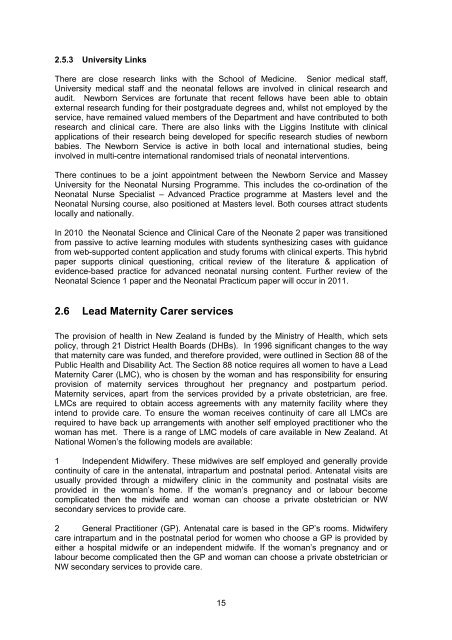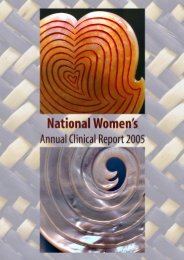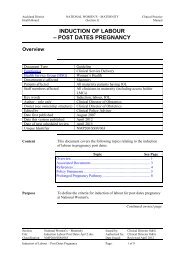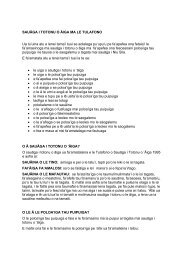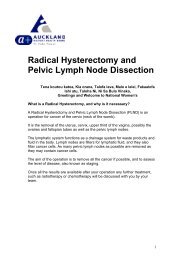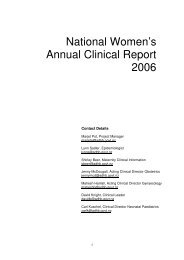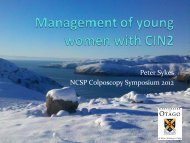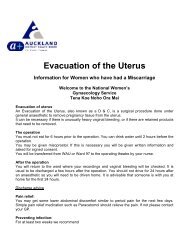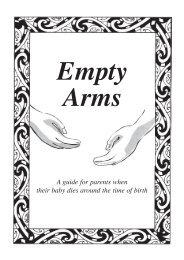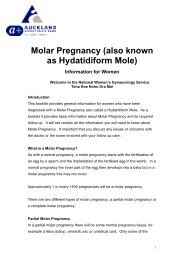National Women's Annual Clinical Report 2010
National Women's Annual Clinical Report 2010
National Women's Annual Clinical Report 2010
Create successful ePaper yourself
Turn your PDF publications into a flip-book with our unique Google optimized e-Paper software.
2.5.3 University Links<br />
There are close research links with the School of Medicine. Senior medical staff,<br />
University medical staff and the neonatal fellows are involved in clinical research and<br />
audit. Newborn Services are fortunate that recent fellows have been able to obtain<br />
external research funding for their postgraduate degrees and, whilst not employed by the<br />
service, have remained valued members of the Department and have contributed to both<br />
research and clinical care. There are also links with the Liggins Institute with clinical<br />
applications of their research being developed for specific research studies of newborn<br />
babies. The Newborn Service is active in both local and international studies, being<br />
involved in multi-centre international randomised trials of neonatal interventions.<br />
There continues to be a joint appointment between the Newborn Service and Massey<br />
University for the Neonatal Nursing Programme. This includes the co-ordination of the<br />
Neonatal Nurse Specialist – Advanced Practice programme at Masters level and the<br />
Neonatal Nursing course, also positioned at Masters level. Both courses attract students<br />
locally and nationally.<br />
In <strong>2010</strong> the Neonatal Science and <strong>Clinical</strong> Care of the Neonate 2 paper was transitioned<br />
from passive to active learning modules with students synthesizing cases with guidance<br />
from web-supported content application and study forums with clinical experts. This hybrid<br />
paper supports clinical questioning, critical review of the literature & application of<br />
evidence-based practice for advanced neonatal nursing content. Further review of the<br />
Neonatal Science 1 paper and the Neonatal Practicum paper will occur in 2011.<br />
2.6 Lead Maternity Carer services<br />
The provision of health in New Zealand is funded by the Ministry of Health, which sets<br />
policy, through 21 District Health Boards (DHBs). In 1996 significant changes to the way<br />
that maternity care was funded, and therefore provided, were outlined in Section 88 of the<br />
Public Health and Disability Act. The Section 88 notice requires all women to have a Lead<br />
Maternity Carer (LMC), who is chosen by the woman and has responsibility for ensuring<br />
provision of maternity services throughout her pregnancy and postpartum period.<br />
Maternity services, apart from the services provided by a private obstetrician, are free.<br />
LMCs are required to obtain access agreements with any maternity facility where they<br />
intend to provide care. To ensure the woman receives continuity of care all LMCs are<br />
required to have back up arrangements with another self employed practitioner who the<br />
woman has met. There is a range of LMC models of care available in New Zealand. At<br />
<strong>National</strong> Women’s the following models are available:<br />
1 Independent Midwifery. These midwives are self employed and generally provide<br />
continuity of care in the antenatal, intrapartum and postnatal period. Antenatal visits are<br />
usually provided through a midwifery clinic in the community and postnatal visits are<br />
provided in the woman’s home. If the woman’s pregnancy and or labour become<br />
complicated then the midwife and woman can choose a private obstetrician or NW<br />
secondary services to provide care.<br />
2 General Practitioner (GP). Antenatal care is based in the GP’s rooms. Midwifery<br />
care intrapartum and in the postnatal period for women who choose a GP is provided by<br />
either a hospital midwife or an independent midwife. If the woman’s pregnancy and or<br />
labour become complicated then the GP and woman can choose a private obstetrician or<br />
NW secondary services to provide care.<br />
15


